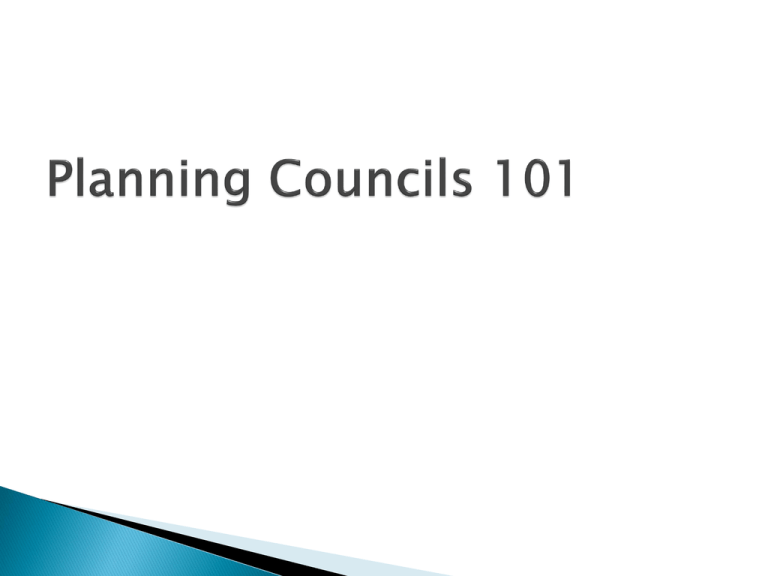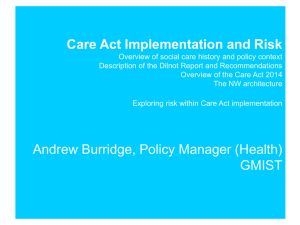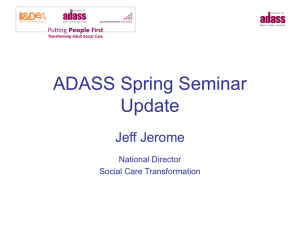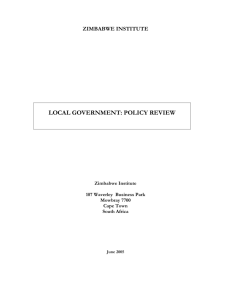OBH Orientation Presentation 2014
advertisement

Provide overview of the block grant statute requiring planning councils Provide overview of statutory responsibilities of planning councils Describe context for changes in block grant Provide considerations in combined Behavioral Health Planning Council SAMHSA’s Strategic Initiatives Block Grant - Impact on State Authorities and Systems Block Grant Programs’ Goals ◦ The block grant is a formula grant awarded to States based upon an allotment calculated for each fiscal year by a legislated formula. ◦ Awards are made in response to the States’ applications and to the implementation reports submitted by the States for the previous fiscal year • • As a result of federal law 99-660 in 1986, continuing through Public Law 101-639 and Public Law 102-321 in 1992, and continued in the current 106-310: Mental health planning and advisory councils (PACs) exist in every State and U.S. Territory. Current SAMHSA reauthorization bill again includes councils. • • The law requires States to perform mental health planning in order to receive federal Mental Health (MH) Block Grant funds Each State or U.S Jurisdiction has submitted an annual MH Block Grant application plan due September 1 of each year. Substance Abuse Prevention and Treatment (SAPT) application has been due December 1. • Each State submits an MH implementation report due Dec. 1 reporting on the previous year’s block grant fund expenditures and implementation Planning Councils must contain the following people: •Representatives from the following State agencies: Mental Health, Education, Vocational Rehabilitation, Criminal Justice, Housing, Social Services, and the State Medicaid Agency Because of cultural factors, several jurisdictions do not include a housing representative •Public and private entities concerned with the need, planning, operation, funding, and use of mental health services and related support services • • Adults with serious mental illness who are receiving (or have received) mental health services. Families of such adults and families of children with serious emotional disturbance: The ratio of parents of children with serious emotional disturbance to other members of the council must be sufficient to provide adequate representation of such children. • Most importantly, the law states that not less than 50% of the members of the councils are individuals who are NOT State employees or providers of mental health services. How to define “providers” ? Peer providers? 1. To review the Mental Health Block Grant Plan and to make recommendations. 2. To serve as an advocate for adults with a serious mental illness, children with a serious emotional disturbance, and other individuals with mental illnesses. 3. To monitor, review, and evaluate, not less than once each year, the allocation and adequacy of mental health services within the State. Affordable Care Act signed in to law and recently upheld by the Supreme Court Increased focus on integration of services and development of Health Homes Greater emphasis on prevention and wellness Emphasis on recovery focus and expansion of peer services • • • • SAMHSA is urging States to integrate MH and SA into Behavioral Health Planning Councils There are some challenges in doing so, as statute requires MH planning council but not SA Behavioral health planning councils must still meet the statutory requirements for MH planning councils Colorado has taken a lead to integrate and created a behavioral health planning and advisory council 12 SAMHSA has created an combined substance abuse treatment and prevention and mental health block grant application, in part in preparation for possible ACA implementation As of Sept. 1, 2011, 22 States submitted a combined application SAMHSA has adopted a new submission schedule for the combined BG application Combined application is for a two year period and can be updated by the State during the two year period Colorado has combined its application Prevention of Substance Abuse and Mental Illness Trauma and Justice Military Families Recovery Support Health Reform Health Information Technology Data, Outcomes, and Quality Public Awareness and Support States should be more strategic in their efforts to purchase services States should think more broadly than the populations they have historically served through Federal Block Grants and other funding. States should design and develop collaborative plans for health information systems. Interoperable information technology systems that allow for the effective exchange and utilization of health data. States may form strategic partnerships in order for individuals to have access to a good and modern services system. State authorities should focus more on recovery from mental health and substance use problems. State authorities should monitor the coverage of behavioral health services offered by qualified health plans and Medicaid to ensure that individuals with behavioral health conditions have adequate coverage and access to services States should make primary substance abuse prevention a priority. State authorities should be strategic in leveraging scarce resources to fund prevention services. State authorities should monitor Exchanges to ensure that individuals with behavioral health conditions are aware of their eligibility, able to get enrolled, and able to stay enrolled. State authorities should make every effort to ensure that the right recipient is receiving the right payment for the right reason at the right time. State authorities should use evidence to support their funding and purchasing decisions. State authorities should ensure that they comport with changes in quality reporting. State authorities should pay particular attention to trauma. State authorities should collaborate closely with their counterparts in the criminal and juvenile justice systems. States authorities should monitor compliance with the federal parity law to ensure that individuals with behavioral health conditions are receiving the mandated coverage and access State authorities should be key players in primary and behavioral health care integration activities. Population changes in many states have created a demographic imperative to focus on improving behavioral health care for diverse racial, ethnic, and LGBTQ populations with the goal of reducing disparities for these subpopulations. State authorities are encouraged to implement, track, and monitor recovery-oriented, quality behavioral health care services within their states as authorized under the SABG and MHBG. State authorities should ensure that their states have a system of care approach to children’s and adolescents’ behavioral health services. The components of a healthy life are the dimensions of recovery: A physically and emotionally healthy lifestyle (health); o A stable, safe and supportive place to live (a home); o Meaningful daily activities such as a job, school, volunteerism, family caretaking, or creative endeavors and the independence, income, and resources to participate in society (a purpose); o Relationships and social networks that provide support, friendship, love, and hope (a community). o Additional aims of the Block Grant programs: o The focus is about everyone, not just those with an illness or disease, but the whole population. o The focus is on prevention and wellness activities. o The activities are data driven: a public health agency uses surveillance data as well as an analysis of other public health drivers/levers to inform targets of opportunity. o There is an emphasis on access to services and availability. o There is an emphasis on policy impact and support: an analysis of the laws, rules, and infrastructure which informs and supports the work.). Chris Habgood Director of Public Policy and Planning







